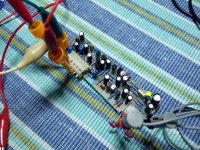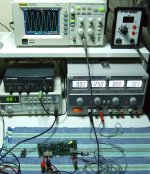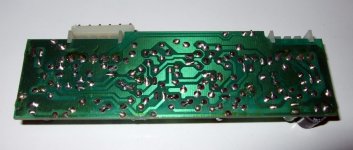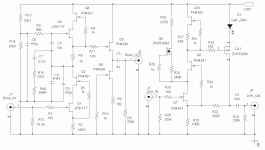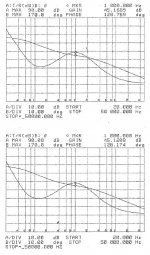One thing that may be attractive about this design is that it's a single-board solution for an audio preamp, with RIAA, line amp, and high quality shunt regulator all in one piece. With quality components it may be pretty good - we'll see. Surely it'll be good enough for broadcast applications, especially considering how much the signal gets chewed up once it leaves the master studio.
I owed pictures... Found the card in some box. Took gain measurements too. Its 54dB indeed the MC one (not SE designated). I.e. expect 250mV RMS from a 0.5mV MC cart. Seen driven with 1mV for 500mV RMS in the pics. Negative sine peak gets clipped at 6VRMS. At 8VRMS sine is clipped up and down. Input load is 220 Ohm.
Attachments
Well, looking at the components on the board, I certainly ain't writing home about it. Trying to wring MC amplification levels out of a single stage was an exercise in hubris (though no doubt the accountants were all weak in the knees about the cost savings). I'll confine my efforts here to MM-type signal levels, where this design makes much more sense. With cascoding and a low capacitance/low noise fet like the 2SK117, it makes a whole lot of sense for broadcast-type cartridges that have upwards of a Henry of inductance (look up the specs for the Stanton 680 - it'll make your hair stand up on end..).
The previous post wasn't aimed at you, Salas, but at others who may not be sufficiently grounded in reality. My very first diyaudio thread "Broadcast RIAA Blues" (many years ago), recounted experiences I'd had with the (more or less) 2nd quietest opamp in the world (the LT1115) confronted with the inductance of the Stanton 680 series broadcast cartridge - not nice, noise-wise. High bias current X high indcuctance = high noise.That particular situation was fixed via Scott Wurcer's generous donation of some early DIP-packaged AD745 opamps with JFET input (still pumping out the tunes to this date - thanks, Scott).
I used the knowledge gleaned in that first thread to design some folded cascode discrete opamps using matched 2SK170 at the input, solving some of the problems recognized earlier with the low-noise bipolar opamps, but sill not optimal. This next pass is applying low noise, low capacitance, open loop input stages to the thorny problem of a master studio environment with "broadcast standard" cartridges in the turntables and "sensitive artists" (with everything that implies) at the helm.
I used the knowledge gleaned in that first thread to design some folded cascode discrete opamps using matched 2SK170 at the input, solving some of the problems recognized earlier with the low-noise bipolar opamps, but sill not optimal. This next pass is applying low noise, low capacitance, open loop input stages to the thorny problem of a master studio environment with "broadcast standard" cartridges in the turntables and "sensitive artists" (with everything that implies) at the helm.
Here's the soundtrack to the comment about "sensitive artists" I made in the last post King Missile - Sensitive Artist - YouTube . Enjoy, though John S. Hall has a voice and delivery that makes me want to smack him on general principles...
I managed to stuff and bring up the power supply and input/RIAA sections of the "Creek" preamp, and quiescent voltage levels are right on target. It appears that if you insist on using a cascoded SRPP circuit, the externally biased SRPP circuit (rather than symmetric) is the way to go, as you get to pin the bias levels accurately, at the cost of a big coupling cap. This opens up the way to high gain circuits (like this one) using the 2SK117 or 2SK170. Selection requirements for the jfets are considerably relaxed as well. I've been looking at the circuit as well, and have decided that it needs to be treated as a current driven RIAA stage - we'll see how well that assumption works when I get around to running a frequency response curve. I really need to put an inverse RIAA network together so that I can start generating curves for RIAA deviation.
I've been searching out components to stuff the line amp portion of this preamp module, which incorporates a "Creekish" single-gain stage RIAA preamp. a line amp. and a local shunt Vcc regulator). I was going for a 3-4X lineamp with the PN4391 as input device, and the Fairchild PN4391 jfets I've bought in profusion are pretty much all too hot (reallly high Vgs for a given IDS) to serve as the input device in the line amp portion of the RIAA/lineamp/power supply module I'm contemplating.
I found a small stash of Vishay PN4391 parts (I only have a few left, and I was lucky to find a pair close to my Vgs/Id requirements) that will serve for the time being on this particular project, meaning that I'll have to redesign the line amp portion of the module to accept more readily available parts
Both the Fairchild and the National NOS PN4391s I've recently bought look to be suitable only for cascode duty. This isn't horrible, but it tightens up the topologies available to me for line amp duty (requirements - single ended, single supply (+30V), low distortion, gain from unity to ~10X).
All this makes it more important that I run a gain-phase plot on the "Creek" SRPP RIAA amp I have currently stuffed and working (DC-wise) to determine whether a unity gain line amp is suitable - if so, it really frees up design options in terms of available parts...
When I have everything picked out and working, I'll post some schematics and data. Perhaps then you'll maybe figure out what I'm talking about here...
I found a small stash of Vishay PN4391 parts (I only have a few left, and I was lucky to find a pair close to my Vgs/Id requirements) that will serve for the time being on this particular project, meaning that I'll have to redesign the line amp portion of the module to accept more readily available parts
Both the Fairchild and the National NOS PN4391s I've recently bought look to be suitable only for cascode duty. This isn't horrible, but it tightens up the topologies available to me for line amp duty (requirements - single ended, single supply (+30V), low distortion, gain from unity to ~10X).
All this makes it more important that I run a gain-phase plot on the "Creek" SRPP RIAA amp I have currently stuffed and working (DC-wise) to determine whether a unity gain line amp is suitable - if so, it really frees up design options in terms of available parts...
When I have everything picked out and working, I'll post some schematics and data. Perhaps then you'll maybe figure out what I'm talking about here...
Yes, Q7 really is a PN4391. As I pointed out a couple of posts previously, it's difficult to select that part for proper operation if you have a bunch of hot fets. That position requires a device with 3.8-4V Vgs at 10ma. My recently acquired Fairchild devices are all at 5-6V (or more) Vgs. I managed to find a couple of old Vishay parts that work rather nicely, but others may not be as lucky.
A unity gain stage would be much, much easier to manage, though it will require an input coupling cap - one of several reasons why I wanted to try a stage with gain at first. At any rate, my final decision will depend on the RIAA stage gain, something I'll be measuring once I get some power supply issues straightened out.
For these sorts of projects I use 1% metal film parts where I can - the exception is the gain resistor for the output stage (R22), which will need to be a 2W part to keep the temperatuure down. I currently have a Panasonic metal oxide film part in that position. R15 and R22 really should be 1% parts for RIAA accuracy. Usung looser tolerance parts won't affect the DC setpoints too much, though some tweaking may be required with the current source feeding Q7 in order to get decent output centering.
A unity gain stage would be much, much easier to manage, though it will require an input coupling cap - one of several reasons why I wanted to try a stage with gain at first. At any rate, my final decision will depend on the RIAA stage gain, something I'll be measuring once I get some power supply issues straightened out.
For these sorts of projects I use 1% metal film parts where I can - the exception is the gain resistor for the output stage (R22), which will need to be a 2W part to keep the temperatuure down. I currently have a Panasonic metal oxide film part in that position. R15 and R22 really should be 1% parts for RIAA accuracy. Usung looser tolerance parts won't affect the DC setpoints too much, though some tweaking may be required with the current source feeding Q7 in order to get decent output centering.
Last edited:
Here's the response of the SRPP RIAA section of the preamp. The channels are very well matched, though the 1Hz gain is rather high ( I like to see ~40 dB at 1kHz). If I want to fix that, the answer would be to scale up the RIAA EQ network a bit. I'll do that if I can find some appropriate cap values at the surplus stores. The capacitance will go up by a little under 2X, and the resistors will go down by the same factor. At any rate, it's a start.
The close matching is very pleasing, as I didn't work exceptionally hard to match the fets (the ones that need matching are the bottom fets of the SRPP stages).
The close matching is very pleasing, as I didn't work exceptionally hard to match the fets (the ones that need matching are the bottom fets of the SRPP stages).
Attachments
Last edited:
Another option for taming the gain might be to replace the 2SK117s I'm currently using with the PN4393. These have similarly low input capacitance, but lower transconductance. The noise might be a little higher, but that's probably not a big deal for the intended application.
I also ran a scan on one of the line amp channels. It has gain out to daylight, with peaking at a few MHz. A simple pole across the gain resistor is not enough of a fix (at least in the frequency domain). When I get a little more time, I'll do a square wave response to see what's happening in the time domain (always a nice sanity check).
I also ran a scan on one of the line amp channels. It has gain out to daylight, with peaking at a few MHz. A simple pole across the gain resistor is not enough of a fix (at least in the frequency domain). When I get a little more time, I'll do a square wave response to see what's happening in the time domain (always a nice sanity check).
An interesting point - just tonight the radio station engineer slipped me a new Ortofon cartridge designed for studio duty. The output spec is 8mV - huge compared to your run of the mill MM cartridge. I may have to sit on the gain of the broadcast version of this preamp a lot more than I thought.
There are two parameters that can be manipulated in the SRPP phono stage for gain scaling - the RIAA network, and the transconductance of the SRPP bottom fet. When I have a better handle on things, I'll put thd Ortofon on a headshell, load it into one of my 1200s. I have a lot of hot DJ vinyl that can be used to check for overload, as well as the usual test records. I'm also interested to see what the cartridge will demand in terms of loading - the coil inductance is ~1/2 Henry.
There are two parameters that can be manipulated in the SRPP phono stage for gain scaling - the RIAA network, and the transconductance of the SRPP bottom fet. When I have a better handle on things, I'll put thd Ortofon on a headshell, load it into one of my 1200s. I have a lot of hot DJ vinyl that can be used to check for overload, as well as the usual test records. I'm also interested to see what the cartridge will demand in terms of loading - the coil inductance is ~1/2 Henry.
- Home
- Source & Line
- Analogue Source
- JFET SRPP RIAA Preamp
